Scottish secondary schools and their links with developing countries: study
This study on school partnership and school visits in a global citizenship context supports discussions on global learning, international development, school partnerships and volunteering.
5. A Malawian Perspective
5.1 Introduction
The literature review (Chapter 2) showed that there currently is a lack of research on the impact of partnerships and visits on the schools in the developing countries. Moreover, there is very little insight in what motivates those schools to join programmes and partnerships and their perception of the current implementation and impact of partnerships and visits. Although a large-scale study was beyond the scope of this research, an initial exploration was undertaken to gather insights in Malawian teachers’ perception on the partnership.
A questionnaire was sent to the partner schools of the Scottish schools that had a link to Malawi. In this questionnaire teachers were asked to describe the practicalities of the partnership as well as their perceived benefits and potential challenges. Appendix III includes a more detailed description of the methodology. The aim of the questionnaire was to gather initial insights in the Malawian teachers’ understanding of partnerships and school visits. The sample was not representative and no generalizations can be made from it. However, it does provide important discussion points for evaluating partnerships and global learning.
5.2 Survey Results
Highlights
- 50% of partnerships were established through a personal contact with a Scottish teacher.
- The main motivations for establishing the school partnership were friendship, learning and sharing and educational support.
- Around 42% of schools were in contact a couple of times a month followed by about 26% of school a couple of times a year and this was mainly via email or WhatsApp.
- 50% of Malawian schools reported receiving resource and/or funding from their Scottish partner.
- Over 50% of Malawian schools had hosted Scottish students.
- All partnerships were reported as meeting the expectation of the Malawian partner and almost all Malawian schools said there needs and ideas were well integrated into the partnership.
- Key challenge in maintaining the partnership was the low levels or slow communication which is a key area they would like to see improve. The was also linked to a change in management which impacts on the partnership.
- Equal exchange in visits was a key area Malawian schools would like to improve in the future but costs were cited as a major barrier.
- Main activities for visiting Scottish student were classroom construction and renovation along with joint lesson and shared activities.
Twenty primary and secondary schools across Malawi returned the questionnaire. Completed questionnaires were submitted from 12 primary schools and 8 secondary schools; from 6 schools in the southern region of Malawi and 14 in the northern region of Malawi. None were submitted from the central region.
All Malawian schools had established partnership with one Scottish school with the exception of two, which has partnerships with two Scottish schools. All partnerships were active at the time of the survey with the exception of one which ended after three years in 2017.
Of the schools surveyed the earliest school partnership commenced in 2000 followed by two further partnerships in 2006 and 2007. Two other schools commenced partnerships in the early 2010s, but the majority, which totalled nine schools (45%) started between 2016 and 2019. Six of the schools did not know when their partnerships commenced.
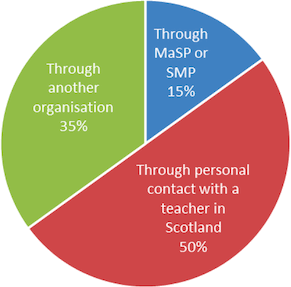
All the Malawi schools partnered with a same grade school, which the exception of one.
Half of the schools (50%) created the partnerships via personal contacts with a teacher in Scotland; Just over a third (35%) through an unspecified organisation and the remaining 15% through the Scottish Government supported Malawi-Scotland Partnership (MaSP – Malawi-based) or the Scotland-Malawi Partnership (SMP – Scotland based) (figure 1). Other organisations that facilitated partnerships included the British Council’s via their Connect Classrooms programme; The Chesney Trust UK; Mary’s Meals, a school feeding charity; Classroom’s for Malawi and Malawian district education officers.
The Malawian school’s motivation for establishing a partnership with a Scottish school were diverse and each responded listed a number of reasons (figure 2). The most listed motivations were learning and sharing; friendship, and; educational support (n = 6). These were followed by joint education projects, and; support with school resources, which was mainly around support with school buildings and in one case financial support (n = 5). Gaining global experiences, often in language and cultural exchanges, was a motivation for four schools and two schools listed peer-to-peer learning for teachers as a key motivation. One school listed hosting visiting volunteers to support disable children as their key motivation for the partnership.
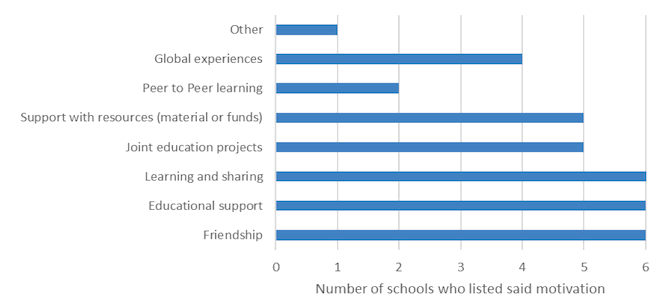
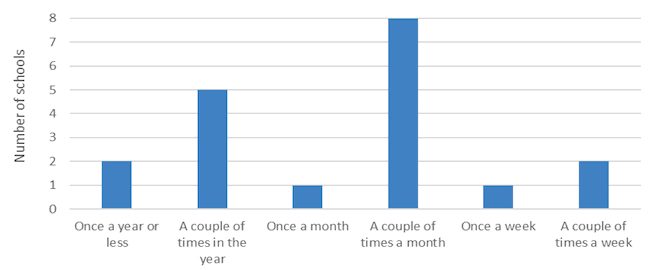
Of the 20 schools who responded to the survey, 19 detailed the frequency of contact with their Scottish partners (figure 3). The most cited frequency was a couple of times per month for eight schools (42%), followed by a couple of times a year of five schools (26%). Three schools had a high frequency of contact i.e. over once a week (16%).
The most frequent method of contact between Malawian and Scottish partners is email followed by WhatsApp (figure 4). Exchange visits was listed by three schools as modes of contact as well as Face time and Skype for two schools. Phone calls and letters were also listed a modes of communication.
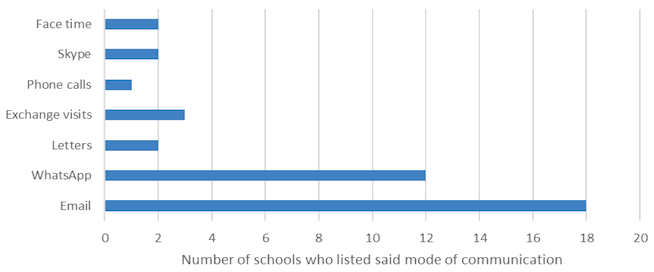
When asked what activities the Malawian schools engaged in with their Scottish partner schools, 50% listed “receiving resources and funds” (n = 10). This was followed by the sharing of teaching methods and projects, listed by seven schools (Figure 5). The exchange of gifts, pictures and letters and Scottish teachers visiting Malawi was the next most cited activities by six schools. Four schools listed Malawian teachers as having visited Scotland and two more as exchanging visits with no further details. Hosting Scottish students in Malawi was listed by three schools, as was building classrooms. When asked if these activities met the expectation of the Malawian partner, all except one said yes. Where the Malawian partner’s expectation was not met, the activity undertaken was building classrooms. The reason the expectation was not met was due to the enduring relationship post activity rather than in relation to the activity itself.
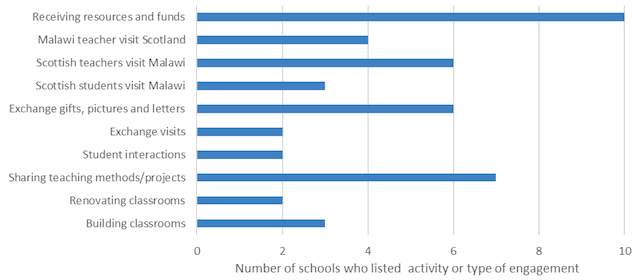
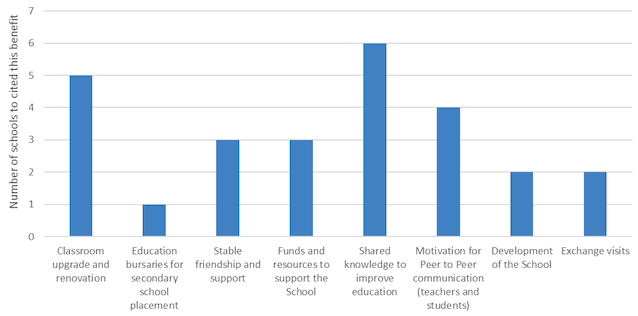
Also, most of the Malawian schools felt that their needs and ideas for their school are well integrated in the partnership. A range of benefits were mentioned, ranging from shared knowledge to improve education and being engaged in peer-to-peer communication to an upgraded classroom and funds and resources to support the schools. Only one said no, which was stated as due to the lack of engagement of the learners during visits and letter exchanges. It is unclear if this is in relation to the Scottish or the Malawian learners.
When asked about key challenges for sustaining the partnership, six schools said that they faced no challenges and all was working well (figure 7). Six schools said communication was a key challenge and this was in relations to a lack of communication; slow response rates; and for one, limited involvement of learners in Scotland which made peer-to-peer learning for students difficult. A lack of communication was also linked with change in management, which also caused disengagement of Malawian partners. Cost of visits, especially in the cases of Malawian visiting Scotland was a key challenged cited by four schools. In the case of other challenges, poor internet access and the issue of visits to Scotland being undertaken by head teachers, which limits the impact to the school if the head teacher moves to another school, were mentioned. One other challenged cited was that the partnership, which was based on receiving resources, had limited impacts as once the school building was finished, support with educational development declined.
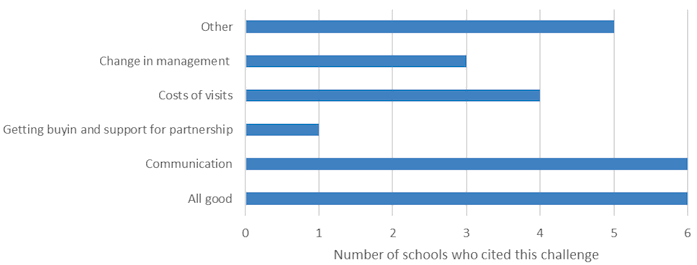
Looking into the future of their partnership over 50% (n = 11) of the Malawian schools wanted an exchange of visits for teachers and students (figure 8). In some cases, this was to improve education support and solidify the partnership; and for other this was about motivating students and teachers to better engage and learn from each other. Other future developments included better communications (n = 3) and the maintenance of friendship already developed (n = 2).
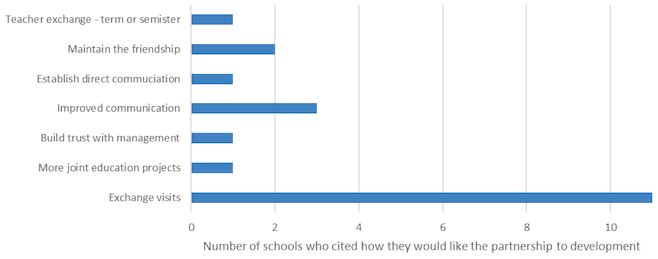
Over half of the projects surveyed (n = 11) had had visits from Scottish students and two schools did not know (figure 9). Of these 11 schools, 10 detailed what activities the school students participated in, the most cited activity was building and renovating classrooms (n = 8), followed by joint activities and joint lessons. Other activities included visiting other schools, sightseeing, cultural exchanges, sports and developing student to student friendships.
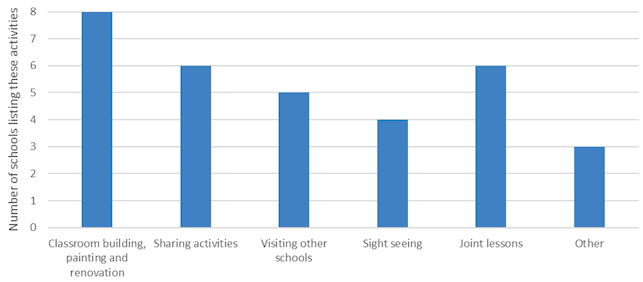
In supporting theses visits, in all but one case the Malawian school where involved in the organisation of these activities and provided a range of support such as organising classes, joint lessons plans and social activities including cultural dances for the students. For the visits that included classroom building or painting, the school was involved in identifying the need and location for the construction or renovation of school buildings and finding sources materials. Some of the schools that had Scottish students visiting to renovate or paint buildings also mentioned that they planned shared or cultural experiences, it remains unclear, however, whether these shared experiences involved joint lessons or peer-to-peer learning.
5.3 Discussion
This first exploration of the impact of partnerships on Malawian schools shows that there is a variety of motivations and outcomes involved, similar to what we have seen in the Scottish schools (Chapter 4). Partnerships for the Malawian schools often include a mix of receiving funding and resources, support and friendship for teachers, and shared learning. Although much more detailed research is needed to understand the impact of these different outcomes and motivations the exploratory data highlights some interesting questions.
First of all, it is interesting to note that half of the respondents stated that they developed the partnership through personal contacts. In line with the conversations with the Scottish teachers, both studies have not shown clearly how partnerships are first developed. A variety of contacts, organisations and spontaneous meetings can be involved in a school developing a partnership. This asks for a better grasp on these processes, for example to understand where, when first meetings are set up, both school get information and support.
One of the main constraints mentioned by the Malawian teachers was communication. This could be due to technical issues such as poor internet connection, or difficulty maintaining contact due to staff changes. This was also identified by the Scottish teachers as one of the challenges of a partnership. Yet, it is important to ensure long term engagement and continuity of a partnership to make sure global learning outcomes are met. This long-term stability was also something that was wanted, as one school mentioned that their link faded after the Scottish students had visited and renovated their school building, which they felt prevented any further development of partnership and friendship.
That an equal partnership was valued is also shown in the repeated appeal for exchange visits. The answers showed that face-to-face contact is valued and seen as a way to solidify and develop the depth of the partnership, as the schools saw more opportunities for learning. This reveals a strong interest in developing the partnership beyond resource support and a belief that linking to a school in Scotland can benefit learning on both sides. For some schools this was mainly focused on the exchange of knowledge and practices by teachers, one respondent for example suggested that teachers from both the Scottish and Malawian school could work in the other school for six months. Other schools mentioned they would like to see more peer-to-peer exchange and Malawian students visiting Scotland as well as Scottish students visiting Malawi. This raises questions about whether through current contacts shared learning is not reached and why, as well as what the current value is of Scottish students visiting. Only exchange visits were stated as beneficial, where Scottish students visited the benefit was often in the construction or renovation of a classroom. Although most respondents mentioned that they would arrange cultural activities for the visiting Scottish students, it remained unclear how much of these trips involved peer-to-peer learning.
Contact
Email: Tasha.Boardman@gov.scot
There is a problem
Thanks for your feedback